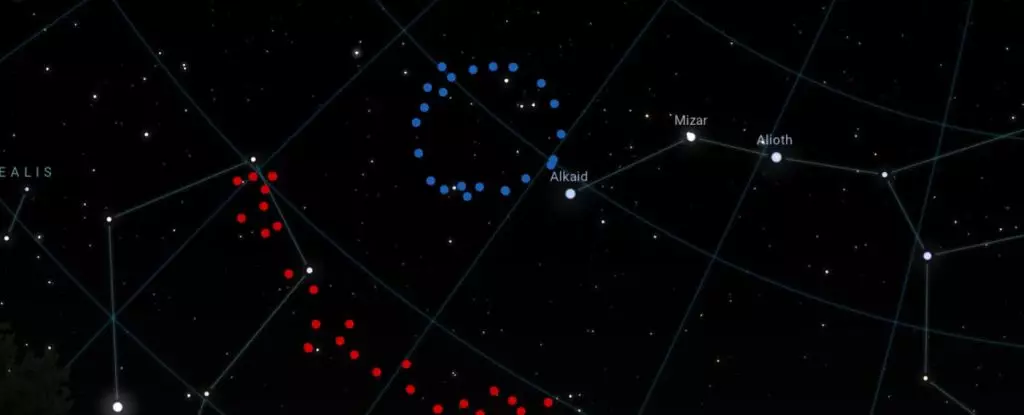In a stunning revelation that could potentially upend our current understanding of cosmic structures, astronomers have unveiled what is now referred to as the Big Ring — a colossal configuration of galaxies extending approximately 1.3 billion light-years in diameter. This extraordinary formation has emerged from light that has traversed the universe for an astonishing 6.9 billion years, arriving as a profound mystery designed to challenge our established cosmological beliefs. Alexia Lopez, an astronomer from the University of Central Lancashire, spearheaded this groundbreaking work, which was recently presented at the 243rd meeting of the American Astronomical Society and subsequently published in the Journal of Cosmology and Astroparticle Physics.
The Big Ring follows the discovery of the Giant Arc, another massive structure that occupies a similar slice of sky and shares comparable distances. Lopez’s findings raise compelling questions about the fabric of the universe and whether we need to rethink the foundational principles that govern cosmology. The very existence of two such gigantic formations in proximity is perplexing. Lopez articulated the urgent need for explanations, emphasizing, “Neither of these two ultra-large structures is easy to explain in our current understanding of the universe.”
Debunking the Standards
Traditionally, cosmology has operated under the assumption that the universe is mostly uniform on large scales, as articulated by the Cosmological Principle. This principle stipulates that any given patch of the universe should resemble any other patch when viewed across vast distances. Yet, the unprecedented dimensions of both the Giant Arc and the Big Ring unequivocally defy this assumption. With current theoretical models suggesting that the largest expected structures should top out at around 1.2 billion light-years, the discovery forces us to recalibrate our expectations and adapt our theories.
Lopez and her team have scrutinized the ring’s structure to ascertain what it might signify. Initial investigations suggest possible links to Baryon Acoustic Oscillations (BAO), remnants of early cosmic acoustic waves; however, the Big Ring doesn’t conform to the established BAO size norms. Instead of a spherical form, it displays a spiral shape reminiscent of a corkscrew, raising further concerns regarding its classification and relevance in cosmological studies.
The Cosmic Implications
The implications of discovering such large-scale structures extend far beyond mere academic curiosity; they touch upon the very nature of cosmic evolution. The consensus among cosmologists is that the observable universe operates under principles that were largely defined by prior discoveries and models. Notably, Roger Penrose’s theory of conformal cyclic cosmology posits that the universe exists in an infinite series of Big Bangs, whereby structures like the Big Ring could emerge. However, this model is not without its own significant challenges, suggesting that any victories in understanding may be overshadowed by more questions.
In parallel, other theoretical frameworks have posited the existence of cosmic strings — hypothesized topological defects in spacetime formed during the universe’s rapid inflation post-Big Bang. While these intriguing ideas pave pathways for potential explanations, the lack of concrete evidence means that they remain largely speculative.
Moreover, with current theories suggesting that such vast cosmic structures should be exceedingly rare, the likelihood that the Big Ring and Giant Arc are mere chance alignments of galaxies becomes increasingly improbable. Lopez remains hopeful that hunting for additional formations of this caliber will uncover more cosmic marvels, reshaping what we conceive of as the universe’s structure.
Fostering a Paradigm Shift
The discoveries made by Lopez and her colleagues compel us to reconsider not only the mechanics of large-scale cosmology but also to embrace a more nuanced awareness of the universe’s chaotic tapestry. Previous models, built on decades of data, have served as a backbone for our current understanding, but with the emergence of the Big Ring, we stand at a juncture of potential paradigm shifts.
It begs the question: do we cling to existing frameworks, or do we dare to venture into uncharted territories of cosmological thought? The natural urge is to cling to familiarity, yet the universe, with all its mysteries, beckons us toward a more expansive understanding. As discoveries evolve, so too must our interpretations. The Big Ring may just be the beginning of a series of revelations that could redefine how we view our cosmos and our place within it. Instead of mere observers, we could become pioneers venturing beyond the limits of our current knowledge.
Lopez’s insistence on the importance of these ultra-large structures calls for an academic resilience which is essential for any field striving to evolve. The anticipation of uncovering further cosmic wonders holds within it the potential to not only enrich our scientific endeavors but to deepen our connection to the universe itself.

